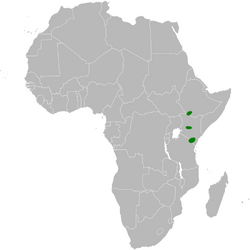Biology:Friedmann's lark
| Friedmann's lark | |
|---|---|
| Scientific classification | |
| Domain: | Eukaryota |
| Kingdom: | Animalia |
| Phylum: | Chordata |
| Class: | Aves |
| Order: | Passeriformes |
| Family: | Alaudidae |
| Genus: | Mirafra |
| Species: | M. pulpa
|
| Binomial name | |
| Mirafra pulpa Friedmann, 1930
| |

| |
| Synonyms | |
| |
Friedmann's lark (Mirafra pulpa) is a species of lark in the family Alaudidae found in East Africa.
Taxonomy and systematics
Formerly, some authorities considered Friedmann's lark to be a subspecies of the singing bush lark.[2] Alternate names for the species include Friedmann's bush lark, rufous lark and Sagon lark.
Description
It is best identified by its distinctive song; a long, drawn-out singular note, hoo-ee-oo (with slight stress on the ee), repeated at 1 or 2 second intervals. It is heard more often at night, and given while atop a bush or during undulating display flights.[3]
Distribution and habitat
Friedmann's lark is found in southern Ethiopia, central and south-eastern Kenya, and north-eastern Tanzania, but its population and exact range are very poorly known.[3] The type specimen was collected in Ethiopia (from the Konso-Sagan area) in 1992, having been seen only one time since, in 1998; but most of what is known comes primarily from data collected in Tsavo East and West National Parks, in Kenya.[3] There are also a few records from Tanzania, from Mkomazi Game Reserve, south of Arusha.[3]
In general, the natural habitats of Friedmann's lark are subtropical or tropical dry lowland grasslands.[4] Being aloof and shy, it apparently chooses the moister (or less dry), ranker-growing of these areas, and where it can find it, those with more bush-cover. This is in contrast to the more dry, and more open environs preferred by many other species of lark.[3]
Behaviour and ecology
It is nearly always witnessed only during certain times of year (in Tanzania, during rainy season, for example), to the exclusion of other times; and often amongst other migrant species. These observations would seem to suggest that it is a migratory bird, but more corroborating data is needed to make a definitive determination.[3]
Friedmann's lark appears to subsist mainly on small beetles, grasshoppers and other insects, as well as grass seeds.[3]
References
- ↑ BirdLife International (2016). "Mirafra pulpa". IUCN Red List of Threatened Species 2016: e.T22717033A94518753. doi:10.2305/IUCN.UK.2016-3.RLTS.T22717033A94518753.en. https://www.iucnredlist.org/species/22717033/94518753. Retrieved 12 November 2021.
- ↑ "Mirafra pulpa - Avibase". http://avibase.bsc-eoc.org/species.jsp?avibaseid=F22CCF784378EA09.
- ↑ 3.0 3.1 3.2 3.3 3.4 3.5 3.6 Phil Benstead, et al.; Friedmann's Lark - BirdLife Species Factsheet
- ↑ "Friedmann's Lark - BirdLife Species Factsheet (Additional Data)". BirdLife International. 2008. http://www.birdlife.org/datazone/species/index.html?action=SpcHTMDetails.asp&sid=8100&m=1.
Cited works
- Phil Benstead; Stuart Butchart (2008). "Friedmann's Lark - BirdLife Species Factsheet". Evaluators: Jeremy Bird, Stuart Butchart, Alison Stattersfield. BirdLife International. http://www.birdlife.org/datazone/species/index.html?action=SpcHTMDetails.asp&sid=8100&m=0.
Wikidata ☰ Q950484 entry
 |


